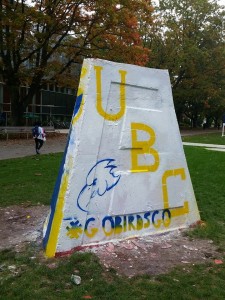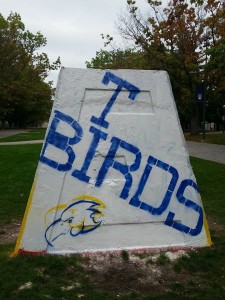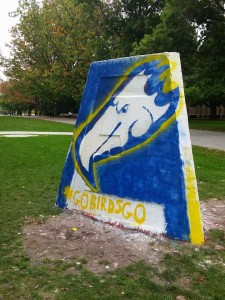On November 13th, 2014 I attended one of the many protests students have been organizing in order to combat the proposed increases in fees international students would have to pay both for classes and residence. To be perfectly honest, I wasn’t sure what I wanted to get out of being in the event but I knew that I was going to be able to use the event for one of the blog posts that I needed to write for this course. I found it interesting that the events on facebook were called #IAMASTUDENT, which I find an note-worthy tactic to advertise the event as integral to the student identity – but more so than this I find it interesting that in some ways this event was organized to ‘defend’ the student identity as a whole from external bureaucratic attackers.
I started the event expecting to understand what it was that these people meant and conceived the ‘student identity’ to be, but as soon as the speaker began her speech I was sent into a completely different trip. I don’t remember her name but she mentioned that she was not an international student and she was finishing up her studies this year so she didn’t fit the ‘prototype’ of the student that was affected by the fee increases. I remember that in her speech she acknowledged this fact but she mentioned that she was present at the event because she saw education as a right as opposed to a privilege and she was tired of the way the ‘school system’ was hitting people who had no choice but to be in it. Even though initially she just felt like another angry person who wanted to complain about being in school, what she said has stuck around in my head until today.
After I left the event I found that I ended up caring more about the speaker’s rant against ‘the system’ than I did about the raise in student fees. I felt she was complaining about being locked in for at least four years into a system that she felt she was compelled to bind herself to. I don’t know why she is in school (maybe her parents compelled her to do it, maybe she enjoys studying, or maybe she thinks it’s the fashionable thing to do) but I certainly understood her frustration about being here. I think that it is fairly common to hate on school because of the many assignments we need to finish or because we are taught by the media that students dislike school, but I certainly understood her frustrations.
I was lucky that this event happened very close to the time we talked about W.E.B Du Bois because in some weird way I feel like I’m able to relate his thoughts on what it was like to be a black person post-emancipation to being a student. Obviously I find it ludicrous to compare my position as a student to a black slave, but I found that some of the concepts Du Bois used in his essay The Souls of The Black Folk (1903) to explain his feelings on his identity could also be used to reflect on my identity as a student.
Du Bois describes prejudice as being “the natural defense of culture against barbarism, learning against ignorance, purity against crime” (Du Bois, page 274). In some sort of way, by thinking that I needed to go to university in order to have a good life I feel like I was prejudiced against other paths of life that didn’t involve being here. I can totally see myself not questioning that the fact that life without a university education would be barbarous, uncultured and ignorant. Nowadays that I’ve learnt to be a skeptic and double question everything I do, or everything that I think about I can see just how prejudiced I started my university education.
I feel like I’m also able to use a second sight to understand the double consciousness I have like Du Bois did. Du Bois explained that he was able to find the division between the two consciousnesses he had by considering himself “through the eyes of others” (Du Bois, page. 272). Du Bois explained that he felt he lived in a world “which yielded no true self-consciousness, but only lets [me] see through the revelation of the other world” (Du Bois page 272). To me the two consciousnesses I have are the academic and prejudiced one, and the one that begs that I question everything I do before I get involved.
I feel like what I learnt out of going to the event and considering myself through how the speaker saw me (oppressed) and my subsequent reflections is that I’m truly divided on being here. Originally I thought that my ‘second consciousness’ would be the complete anti-thesis to my prejudiced side but now I am not entirely sure about it as I feel like the ‘second side’ that’s oppressed by the prejudiced side begs that I question more as opposed to taking action. I suppose that involving myself in this event served to help me question what I feel being a student means to me, and I’ve only come out more divided than I was before.


